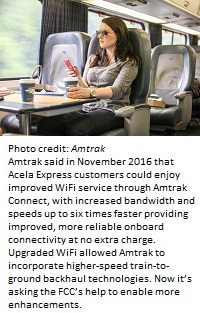
But the railroad wants its WiFi to support high-bandwidth actions. It’s asking permission to operate a Wireless Trackside Network (TSN) under the specifications that apply to fixed point-to-point operation in both the 5.15-5.25 GHz (U-NII-1) and 5.75-5.85 GHz (U-NII-3) bands. The TSN would enable Amtrak to satisfy the growing demand for high-capacity broadband service on its trains in the Northeast Corridor in a technically and commercially viable way.
The TSN has two parts. The first part consists of U-NII access points configured with an 80 megahertz-wide channel installed on 60-foot masts constructed, on average, approximately 0.8 mile apart. These access points are connected to Amtrak’s fiber network, which is connected to the internet. The second part consists of two radios installed on each train that communicate with the access points. The trackside access points use a directional antenna with a narrow bandwidth to maximize the transmission along the Amtrak Northeast right-of-way.
The TSN does not operate as a fixed network because the radios on the trains are moving. However it shares many characteristics of a fixed point-to-point network. Amtrak’s mobile operations would essentially operate at a series of fixed linear points along a defined path. A trackside station will only communicate with a single on-train radio at any given time and only transmit when a train is in position to form the other end of the link. Amtrak estimates each link would be active for less than 20 seconds while a train is moving, and more for trains standing at a station. It just needs the waiver for when the trains are moving.
Because Amtrak’s operations will consist of unlicensed devices operating under the FCC’s Part 15 rules, it must not cause harmful interference to licensed users and its operations are not entitled to interference protection. In a decision signed by Office of Engineering and Technology Chief Julius Knapp, the agency granted the waiver and limited the total number of stations involved to 1,000. Further, no more than 50 train-based radios are permitted to transmit simultaneously along the entire Northeast corridor.
June 5, 2017




Reader Interactions